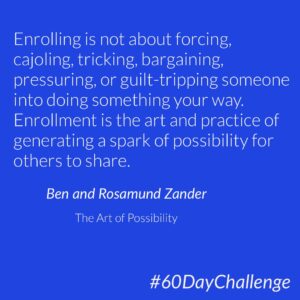 Welcome to Day #7 of the #60DayChallenge! See this post if you need to be brought up to speed!
Welcome to Day #7 of the #60DayChallenge! See this post if you need to be brought up to speed!
OK…let’s dive in…🌊🌊🌊
—–
A week ago the NY Times published an Op-ed from Wharton School organizational psychologist Adam Grant, The Science of Reasoning with Unreasonable People: Don’t try to change someone else’s mind. Instead, help them find their own motivation to change.
From a leadership perspective (and we are all leaders!), it’s an interesting read and connects to much of what we’ve been discussing here since we began a week ago — human-centered school transformation.
As I read and re-read the article, I kept making connections to the art of enrollment which I’ve learned about previously through a number of different channels.
Enrollment is characterized by at least two elements, I think: curiosity and empathy.
I first learned about enrollment reading The Art of Possibility by Ben and Rosamund Zander. (Excellent book, BTW…I think I just convinced myself to revisit it!)
The authors devote an entire chapter to the possibilities offered by enrollment and capture its essence in these words;
Enrolling is not about forcing, cajoling, tricking, bargaining, pressuring, or guilt-tripping someone into doing something your way. Enrollment is the art and practice of generating a spark of possibility for others to share.
The challenge with enrollment is that it takes time and a certain craft/skill to respond to the unique context of each situation. The beauty of it, though, is that it preserves and honors the agency of those you are trying to enroll and deepens the human connection through extended conversation.
It is truly human-centered leadership!
The end result of an enrollment approach is far more lasting if you’re willing to invest the time and energy into designing the possibilities of an idea for others, your organization and yourself.
What does it look like to generate that “spark of possibility for others to share?
In Grant’s article he provides some examples, but here’s a general framework for practicing enrollment. This comes from Education Reimagined as part of their Learning Lab training.
Notice how it’s anchored in curiosity, empathy and honors the agency of the person/people you are trying to influence.
With an interested person:
- Ask/listen – What are your concerns about…
- Invite imagination – What would it be like for you if… What would it be like for your child if….?
- Share – What got me committed to … (Requires vulnerability!)
- Share – What I can be counted on for is to…
- Request – You can support this by….
With a skeptical person:
- Ask/listen – How do you see things? What are your concerns? What is it that I’m not understanding about your point of view?
- Share – What got me committed is….
- Share – What I see to be possible is…
- Agree, and… – I agree. That is a real challenge and it is worth tackling…
- Invite imagination – What would it be like for you if…? What would it be like for your child if…?
- Return to your stand – I am committed to… You can count on me to… (Bring it back to your stand…it’s easy to lose sight of your stance if you don’t reiterate it.)
- Request – Would you be willing to…? (Leaving them with an “ask” they can’t refuse.)
—–
❓ Provocations:
What are some opportunities for you to practice the art of enrollment in your current role?
💎 Resources:
🧠 Mindset:
Enrollment; influence; persuasion
💡 Area:
Leadership
📣 Drop your thoughts in the comments or in the Facebook group, and feel free to share resources.🔥🔥🔥
- A silver lining - January 22, 2022
- Is our use of tech working against us? 🤔 - September 8, 2021
- What’s NOT going to change in the next 10 years? 🤔 - September 7, 2021